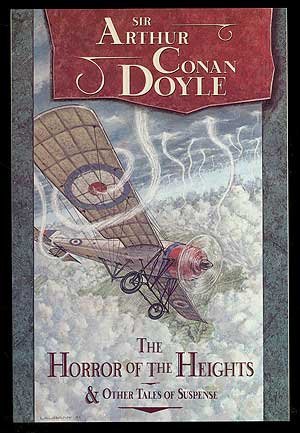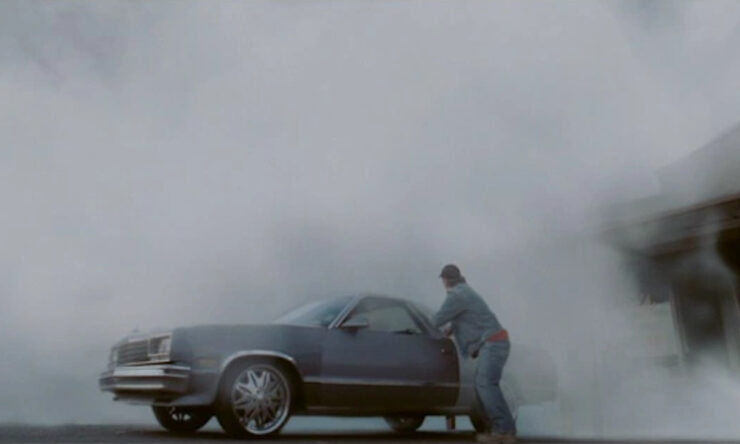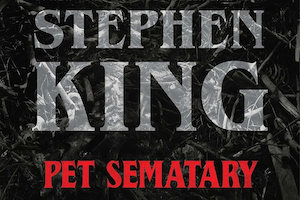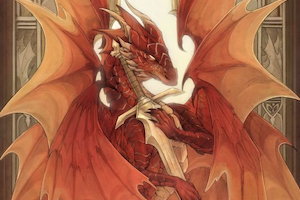Welcome back to Reading the Weird, in which we get girl cooties all over weird fiction, cosmic horror, and Lovecraftiana—from its historical roots through its most recent branches.
This week, we cover Arthur Conan Doyle’s “The Horror of the Heights,” first published in the November 1913 issue of The Strand. Spoilers ahead.
“The whole aspect of this monster was formidable and threatening, and it kept changing its color from a very light mauve to a dark, angry purple so thick that it cast a shadow as it drifted between my monoplane and the sun.”
The (unnamed) author presents in full the narrative known as the Joyce-Armstrong Fragment, found near a Sussex village along with a briar pipe and a pair of broken binoculars. The first two pages of the canvas-backed notebook were missing, while the last was torn away. The bulk of the manuscript was written neatly in pen; the last lines scribbled in pencil. Stains on the cover and last page were determined by Home Office experts to be blood, probably human and infected with the malaria parasite. Tellingly, Mr. Joyce-Armstrong did suffer from intermittent fever.
Though the Fragment contains monstrous assertions, the author refutes suggestions of hoax and warns that we must “readjust our ideas” to the probability our world is “separated by a slight and precarious margin of safety from a most singular and unexpected danger.” Mr. Joyce-Armstrong was an excellent air-pilot, combining an intellectual vigor and daring that allowed him to both invent and test several new aeronautical devices. Devoting much of his wealth to flying, he kept four private planes and made 170 ascents in the last year.
Periodically subject to dark moods, Joyce-Armstrong was strongly affected by the mysterious deaths of four airmen, most with bodies or body parts missing. Take Lt. Myrtle, attempting an altitude record, who fell from over 30,000 feet; his body, otherwise intact, was headless and greasy with an unidentified slime.
The Fragment opens with Joyce-Armstrong’s musings on why so many have ascended over 20,000 feet without encountering the dangers he suspects lurk there. One obvious answer: Only recently have technical improvements allowed pilots to explore the upper layers of the atmosphere. He adds this analogy: One may enter a jungle a thousand times without seeing a tiger, yet tigers exist. JA means to crack the high-altitude record in his new monoplane; armed with a shotgun, he may get a crack at something else as well. If he doesn’t return, his notebook will explain his purpose. In any case, let there be “no drivel about accidents or mysteries, if YOU please.”
Equipped with Arctic garb and an oxygen bag, JA takes off. Gusty winds and heavy rain don’t faze him; he surmounts layers of cloud into a vast region of blue sky and golden sun, with an unbroken plain of glimmering silver beneath him. He hoped to find “an eternal stillness” so high above the earth, but gales accompany him in his steady upward spiral until, having escaped a treacherous air-whirlpool, he reaches 21,000 feet and a still if frigid space. He begins to use his oxygen-inhaler and to experience the startling whiz of meteors around his plane.
At 41,000 feet his plane reaches its limit. And he has now reached the “air-jungle” of his speculations. He encounters “ragged wisps” like cigarette smoke that leave the taste of oil on his lips and a greasy scum on his craft. Might this seemingly organic material, extending off into the void, be the food of monstrous life, as plankton is to the whale? Overhead he spots a tentacle-trailing jellyfish-like being as big as St. Paul’s dome, pink veined with green, a tenuous “fairy outline” pulsing with a delicate rhythm. Hundreds of these drift by, ranging from gargantuan to balloon-sized. Other beings appear, “fantastic coils of vapour-like material” flying at great speed, the “serpents of the outer air.” One touches his face, cold and clammy, but too insubstantial to rouse fear.
Though still jelly-like in substance, the fourth organism to float into view has more solidity and definition than the others. Hundreds of square feet in size, it has two shadowy circular plates on either side (eyes?) and a solid white projection between them curved like a vulture’s beak. It changes color from light mauve to dark purple. On its dorsal curve are three enormous bubbles Joyce-Armstrong supposes to hold a buoyant gas, and it moves by throwing forward glutinous streamers which draw the writhing body after. Gelatinous, it keeps shifting shape, each change more loathsome than the last.
The way it shadows the plane convinces Joyce-Armstrong it means mischief. He dives to escape, but the floating blubber shoots out tentacles that grab at both the plane and himself. Only by discharging both barrels of his shotgun and exploding one of the monster’s bubbles does he free himself to speed back to the safety of the earth.
He has seen both the incomparable beauty and horror of the heights, but he can’t persuade others to believe without evidence. He will fly again to the air-jungle and attempt to capture one of the “jellyfish.” The purple monsters are probably not numerous, and if he sees one, he’ll dive at once.
Author’s note: Here a page of manuscript is missing. What follows is the pencil script, evidently scrawled in Joyce-Armstrong’s monoplane. It reports that, at 43,000 feet, he has three purple monsters beneath him, cutting him off from retreat. His last words: “God help me; it is a dreadful death to die!”
Many may jeer at the facts set down above, but they can’t deny Joyce-Armstrong has disappeared. Let them consider the pilot’s own words: “No drivel about accidents or mysteries, if YOU please.”
What’s Cyclopean: The flying purple people eater has “vague, goggling eyes” full of “viscid hatred.”
The Degenerate Dutch: There is surely something divine in the heroic development of air travel! What nonsense to talk of “human degeneration”!
Weirdbuilding: A fragmentary manuscript containing descriptions of worlds beyond human experience, and the horrible fate that awaits those who encounter them—greater beauty or horror is “not within the ken of man.”
Libronomicon: The Joyce-Armstrong Fragment has an advantage over many fragmentary documents in that it retains most of the important information. Also blood samples. (Doyle is characteristically excited about the potential of forensic science.)
Madness Takes Its Toll: Joyce-Armstrong’s death is “one upon which a man who valued his sanity would prefer not to dwell.”
Anne’s Commentary
We have all become used to unnamed narrators. The narrative in “Horror of the Heights” is that of the dauntless air-pilot Mr. Joyce-Armstrong; the Unnamed One is the author presenting Joyce-Armstrong’s “Fragment,” along with his own strong assertion that the “Fragment” is no hoax, no hoax at all, he tells you! I feel comfortable identifying this author with Arthur Conan Doyle himself, who frequently wrote to defend as true the seemingly incredible.
“The seemingly incredible” is my polite way of saying “the blatantly ridiculous.”
Like many readers I wager, when I think of Doyle, I think of Holmes, of the creator and creation as practically the same being. Wrong, wrong, wrong. As G. K. Chesterton would suggest, “Sir Arthur’s mentality is much more that of Watson than it is of Holmes.” The Dr. James Watson I’m thinking of in this context is the one played by the inimitably bumbling Nigel Bruce alongside the never bumbling Holmes of Basil Rathbone. Can you imagine Sherlock Holmes believing in spiritualism, truly magical magicians, or fairies?
Doyle believed in all three. In 1887, he began attending seances and sitting with mediums. In 1889, he helped found the Hampshire Society for Psychical Research; in 1893, he joined London’s famous Society for the same. So vehemently convinced was he of the truth of spiritualism that he would come to call it God’s “New Revelation,” and he would refuse to believe Margaret Fox (of the infamous Fox sister mediums) when she confessed to perpetrating fraud. Regarding the feats of his then-friend Harry Houdini, Doyle insisted they were actually magical, no matter how strongly Houdini declared they were illusions. And the fairies? Lord, those fairies flitting about a Yorkshire garden so sixteen-year-old Elsie Wright and ten-year-old Frances Griffiths could photograph them for the edification of the gullible, by whom I mean those who couldn’t see that the “fairies” were paper cut-outs strategically arranged in the foreground.
Doyle wrote two pamphlets and a whole book (The Coming of the Fairies) defending the legitimacy of the girls’ “photo documentation” and insisting that fairies were REAL, damn it all.
So it’s not surprising Doyle would structure “The Horror of the Heights” as a frame story in which the unnamed author vehemently defends an incredible narrative from those jeering detractors who just can’t handle the truth. The author tells us that “all who have examined the matter” have abandoned the idea the Joyce-Armstrong Fragment is “an elaborate practical joke evolved by some unknown person, cursed by a perverted and sinister sense of humour.” However wild the Fragment’s assertions, it is “none the less forcing itself upon the general intelligence that they are true.” I guess if you dispute the significance the author ascribes to his meticulously laid-out facts, then you aren’t generally intelligent. Come on. Author doesn’t just write that the bloody notebook was found in Sussex, or even Withyham Village–he knows the name of the exact field where a named laborer employed by a named farmer came upon it. And not just the exact field, but the exact location: in a ditch, among nettles, nettles, mind you, not brambles or (heaven forbid) generic weeds.
Author has done his research. And who can deny there are four cryptically dead pilots, one missing his head? What luck that Joyce-Armstrong wrote such detailed notes about his end–always keep paper and pencil handy, people. You never know when you’ll have to scribble frantic last words prior to anointing the page with your life’s blood, oh, and the Plasmodium parasites consistent with your well-documented malaria. The only thing missing is that ultimate scrawl off the page, the graphic representation of a scream of mind-blown terror.
The density of description in this story reminds me of Lovecraft’s similar works (At the Mountains of Madness, for example.) It’s one of those late 19th-early 20th century stories that Howard describes in Supernatural Horror as narratives that “specialize in events… address the intellect… and take a definite stand with mankind and its welfare.” I think Lovecraft would have indulged in more detail about the upper atmosphere beasties, but Doyle does a good job evoking their unearthliness.
Aerial jellyfish often figure in speculation on possible extraterrestrial life forms. I remember (while forgetting the exact source) a gorgeous artist’s conception of jellyfish navigating the outer layers of Jupiter’s atmosphere. Doyle’s jellies are lovely, his “tigers of the air-jungle” really menacing. Are the air-jungle creatures native to Earth? Or could they have been seeded there by some of those meteors Joyce-Armstrong notes with understandable trepidation?
Either way, Author holds that Joyce-Armstrong’s discovery profoundly alters humanity’s existential situation. “This world of ours,” he writes, “appears to be separated by a slight and precarious margin of safety from a most singular and unexpected danger.” Because what if those gelatinous monsters, alerted to potential feasts below their usual haunts, descend for a snack? What if they are capable of adjusting to higher air pressures? At the least, we’re looking at serious implications for aeronautical exploration and commercial air travel.
Prepare for delays, you frequent flyers, once the tiger-blobs figure out what smorgasbords our passenger jets offer and start hovering over major airports, that’s all I’m saying.
Ruthanna’s Commentary
There is a narrow, winding border between the hyper-masculine adventure tales of the late 19th and early 20th century—confident in the ability of Anglo-Saxon gentlemen to conquer all tigers—and the Lovecraftian suggestion that even the best Men of Action might occasionally get eaten and that’s terrible. After all, if you can’t count on the British Empire standing immortal at the center of history, can existence truly be said to have meaning? These two takes can clash fantastically when they come together; one of our more delightful examples has been Neil Gaiman’s successful merging of Sherlock Holmes with the Mythos.
Arthur Conan Doyle’s own balancing act atop that fence is not nearly so graceful, but fascinating nevertheless. I’m a sucker for obsolete pulp SF, especially when it takes now-common technologies in completely wrong directions. In addition to straddling the line between noble men of action and men who Go Too Far, “Heights” appears to have been written on the last day when you could semi-plausibly discover alien ecologies in an airplane rather than a spaceship. The ecology in question also reminds me of the extradimensional things-you-didn’t-want-to-know-about in “Unseen – Unfeared” and “From Beyond.” We’re not quite at the point of drawing fatalistic philosophical conclusions from the existence of flying purple people eaters, but there’s definitely a hint that maybe there’s only so high you can go, so much you can safely discover. We must readjust our ideas to the new situation.
In addition to foreshadowing later tentacular encounters, we also enjoy here the trope of the dramatically cut-off manuscript, an excellently cheesy way to highlight the dangers of giant fish-monsters, hounds of Tindalos, etc. “This is a real manuscript, really” can add both immediacy and distance to events; I’m fond of it but find the opening exposition/justification a bit dry. I don’t care that much about Joyce-Armstrong’s qualifications as an aviator, or his annoying tendency to drop dark hints about the thing that’s eventually going to eat him, even as I appreciate his willingness to actually document his research. Doyle is ept elsewhere at demonstrating personality through action, and could have done so more effectively here. Hell, Holmes could’ve picked up the notebook in lieu of Anonymous Explainer, and given us a more interesting discourse on the blood it’s soaked in. (Of course, as Anne points out, Holmes could also have IDed potential holes in the story.)
I do appreciate the very anti-Weird closing: “no drivel about accidents or mysteries, if YOU please.” If you’ve got to be eaten by a flying purple people eater, being used to prove the existence of same is really the least you can ask.
And what a fascinating proof. We are still in the “triumph of science” vein here, just barely, and presumably the advanced airplanes and armor and weaponry of the coming years will permit more survivable exploration of the air forests. Maybe we can find out why the flying purple people eaters are so tenacious in hunting these weird fast things that show up in their territory? (Nutrient density, is my guess, but I do also wonder if that density is going to make them sick, given they’re evolved to eat gaseous snakes.) Or if the giant jellyfish sting with those lovely long tendrils, or what the air-snakes look like when they slow down.
There are some things man was not meant to know—and then there are things that are perfectly fine to know, as long as you explore carefully and maybe bring a team with you.
Next week, we continue T. Kingfisher’s The Hollow Places with Chapters 13-14. We’ve come safely home… or maybe not?
Ruthanna Emrys is the author of the Innsmouth Legacy series, including Winter Tide and Deep Roots. Her short story collection, Imperfect Commentaries, is available from Lethe Press. You can find some of her fiction, weird and otherwise, on Tor.com, most recently “The Word of Flesh and Soul.” Ruthanna is online on Twitter and Patreon, and offline in a mysterious manor house with her large, chaotic household—mostly mammalian—outside Washington DC.
Anne M. Pillsworth’s short story “The Madonna of the Abattoir” appears on Tor.com. Her young adult Mythos novel, Summoned, is available from Tor Teen along with sequel Fathomless. She lives in Edgewood, a Victorian trolley car suburb of Providence, Rhode Island, uncomfortably near Joseph Curwen’s underground laboratory.














